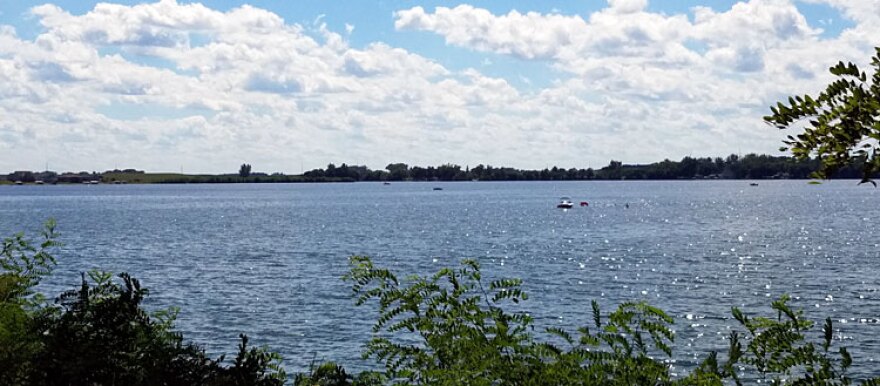Iowa’s Department of Natural Resources is working on finalizing a plan to improve a northwest Iowa lake plagued by poor water quality.
At a Wednesday public meeting in the City of Lake Park in Dickinson County, engineering firm Wenck Associates presented plans to improve Silver Lake, including reducing phosphorus that comes from runoff and managing fish populations like carp and buffalo that harm the lake and promote algae growth.
Silver Lake is a popular spot for boating and fishing, but it has been on the state’s list of impaired waters since 2004. The lake, plagued by algae growth and unwanted fish species, has a very cloudy appearance because of these two factors and wind that stirs sand around in the water.
“Usually a rule of thumb is I want to be able to stand in my lake chest-deep and see my toes,” said Joe Bischoff, an aquatic ecologist who studies lakes for Wenck Associates. “Can you ever do that in Silver Lake?”
“No,” one resident said. “Very seldom,” said another.
The 1,000-acre shallow lake engulfed by a 17,000-acre watershed struggles with water quality because the amount of land mass that surrounds it sends a lot of nutrients to the water. Severe algal blooms caused by phosphorous plague the lake over the summer and can create toxins that can be an issue for human health.
"I want to be able to stand in my lake chest-deep and see my toes. Can you ever do that in Silver Lake?" -Joe Bischoff, Wenck Associates
According to Wenck Associates, 16,000 pounds of phosphorus enter the lake each year from agricultural and manure sources. Bischoff said the state and community need to reduce almost 11,000 pounds of phosphorous to improve water quality over time.
“That’s a daunting task,” Bischoff said. “That’s a lot of phosphorous that needs to be reduced.”
One of the solutions Bischoff mentioned is planting aquatic vegetation in the lake that will uptake the nutrients. A resident expressed concerns that having too many plants in an area of the lake would make it difficult for boaters.
The issue with planting vegetation in water is a double-edged sword because while it reduces nutrients, it simultaneously can hinder boaters and other recreational activities. George Antoniou, a lake restoration program coordinator for the DNR, said other projects the DNR has worked on, like Black Hawk Lake in Sac County, also have vegetation.
The Sac County-area community has developed strategies like harvesting and chemical application to control the vegetation that would still allow people to recreate in open waters, he said.
“If we all agree that we’re trying to improve water quality in Silver Lake, we’re going to have vegetation that we need to deal with and have an understanding of how we’re going to try to manage it,” Antoniou told Iowa Public Radio after the meeting.
Wenck Associates says agricultural production needs to reduce 70 percent of the phosphorous it sends to the lake, while manure management needs an 80 percent reduction. Michelle Balmer, an environmental specialist senior with Iowa’s Department of Natural Resources, said one of the first steps to improving water quality is working with the agricultural community on managing their nutrients and manure.
“If we can work on best management practices like strip-tillage or no-till, grass waterways, terraces, including a wetland restoration, and then on our public ground, working on shoreline restoration, enhancing a wetland...as well as comprehensive fish management of the lake, those are kind of the top priorities,” Balmer said.
Fish like carp and buffalo are abundant in Silver Lake. They stir up sediments that contribute to the lake's cloudiness, and they feed off of the bottom of the lake, which would make it difficult to establish and grow vegetation. Bischoff said these fish populations would have to be dealt with in order to improve water quality.
Matt Carstensen from Lake Park grew up near the lake and says he knows those species all too well.
“Growing up, my brother and I would actually fish for those because they were fun, they fought a lot,” he said. “But obviously they’re not conducive to good water quality and game fish.”
Carstensen said he wants to see water quality improved, but said his community needs to “be realistic” about the goals and realize any action taken won’t yield immediate results.
The DNR is working on a plan for the lake and looking at how they can implement many of the solutions the community discussed. Balmer said her goal is to start to formulate a restoration plan over the next six months.
State environmental officials, over the last year, have been studying fish communities to understand how they work and how they might be able to remove rough fish like carp and buffalo from the area. Balmer said that study will continue for three more years.


